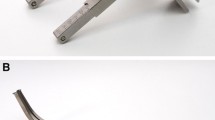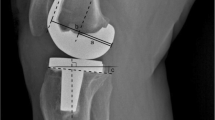Abstract
In cruciate-retaining (CR) type TKA, the increase in posterior condylar offset (PCO) is considered to be correlated to flexion angle acquired postoperatively according to the article reported by Bellemans (J Bone Joint Surg Br 84:50–53, 2002). However, the significance of PCO seems to differ according to the size of joints. We therefore have defined a new parameter of posterior condylar offset ratio (PCOR) on the lateral view of plain X-ray photographs and studied the relationship between PCOR and postoperative flexion status in posterior-stabilized (PS) type TKA. Flexion status includes two parameters, such as postoperative flexion angle (FA) and flexion achievement rate (AR). The subjects of this study were 160 knees (16 males and 144 females, average 75 years.) with PS type TKA for osteoarthritic knees between 1999 and 2003 at our institution, more than at least 1 year postoperative follow-up. In the study of FA, patients with FA of less than 100° were divided into Group L (n = 28), patients with FA of 130° and greater were divided into Group H (n = 58). In the study of AR, patients with AR of less than 100% were divided into Group P (n = 46), patients with AR of 120% and greater were divided into Group G (n = 22). PCOR was statistically compared in each group, respectively. In FA, PCOR in Group L (0.385) was significantly lower (P = 0.027) than that in Group H (0.428). In AR, PCOR in Group P (0.376) was significantly lower (P = 0.0018) than that in Group G (0.456). We have concluded, though there are many factors influencing the range of movement after TKA, our newly defined PCOR could possibly serve as a parameter of postoperative flexion status of PS type TKA on plain X-ray photographs.



Similar content being viewed by others
References
Anouchi YS, McShane M, Kelly F Jr, Elting J, Stiehl J (1996) Range of motion in total knee replacement. Clin Orthop 331:87–92
Bellemans J, Banks S, Victor J, Vandenneucker H, Moemans A (2002) Fluoroscopic analysys of the kinematics of deep flexion in total knee arthroplasty. J Bone Joint Surg Br 84:50–53
Lizaur A, Marco L, Cebrian R (1997) Preoperative factors influencing the range of movement after total knee arthroplasty for severe osteoarthritis. J Bone Joint Surg Br 97:626–629
Matsui N, Arabori M, Kubo S, Yoshiya S, Matsumoto A, Shibanuma H, Kurosaka M (2003) Correlation between posterior condylar offset and flexion angle after total knee arthroplasty: Comparison between crutiate retaining type and posterior stabilized type components. J Jpn Orthop Assoc 77(4):S593
Miner AL, Lingard EA, Wright EA, Sledge CB, Katz JN (2003) Kinemax Outcomes Group Knee range of motion after total knee arthroplasty: how important is this as an outcome measure? J Arthroplasty 18:286–294
Parsley BS, Engh GA, Dwyer KA (1992) Preoperative flexion. Dose it influence postoperative flexion after posterior-crutiate-retaining total knee arthroplasty? Clin Orthop 275:204–210
Ritter MA, Harty LD, Davis KE, Meding JB, Berend ME (2003) Predicting range of motion after total knee arthroplasty. J Bone Joint Surg Am 85:1278–1285
Schurman DJ, Matityahu A, Goodman SB, Maloney W, Woolson S, Shi H, Bloch DA (1998) Prediction of postoperative knee flexion in Insall-Burstein 2 total knee arthroplasty. Clin Orthop 353:175–184
Sultan PG, Most E, Schule S, Li G, Rubash HE (2003) Optimizing flexion after total knee arthroplasty: advances in prosthetic design. Clin Orthop 416:167–173
Walker P, Garg A (1991) Range of motion in total knee arthroplasty. Clin Orthop 262:227–235
Author information
Authors and Affiliations
Corresponding author
Additional information
No benefits or funds were received in support of the study.
Rights and permissions
About this article
Cite this article
Soda, Y., Oishi, J., Nakasa, T. et al. New parameter of flexion after posterior stabilized total knee arthroplasty: posterior condylar offset ratio on X-ray photographs. Arch Orthop Trauma Surg 127, 167–170 (2007). https://doi.org/10.1007/s00402-007-0295-x
Received:
Published:
Issue Date:
DOI: https://doi.org/10.1007/s00402-007-0295-x




